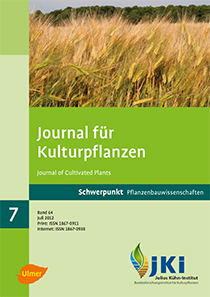Comparison of different near infrared spectrometers and sample presentations to estimate the protein and starch content in cereal grains during trial harvest
DOI:
https://doi.org/10.5073/JfK.2012.07.02Keywords:
NIRS, spectrometer, cereal grain, wheat, barley, triticale, starch, proteinAbstract
Plant breeding requires methods for rapidly detecting the differences in grain quality parameters within the breeding material. Ideally, such methods should be inexpensive and able to be carried out on large samples during or close to the harvest. Therefore, the near infrared spectroscopy has proven to be a suitable method. This research project aims to determine the suitability of various spectrometer systems to achieve this.
As part of a joint field and laboratory project, a comparison was made of two spectrometers commonly used for the analysis of grain samples during harvesting. The spectrometers PSS-1720 (Polytec GmbH, Waldbronn) and two configurations of the Zeiss spectrometer, Corona 45 NIR and Corona Remote NIR (Carl Zeiss Jena GmbH, Jena) were compared using both a conveyor belt system and funnel flow system commonly used on a plot combine. The PSS-2120 (Polytec) was also tested in the combination with the conveyor belt system. The suitability of these systems for determining the starch and protein content of samples of unground wheat, barley and triticale grain was tested. Also the influence of the occurrence of impurities in winter barley samples was investigated.
All the spectrometers produced calibrations with high coefficients of determination for starch and protein content for the cereals under investigation. Overall, the conveyer belt system, when combined with the PSS-1720 spectrometer produced the more accurate calibrations, especially for smaller sample sizes. The calibrations for protein content were more accurate than for starch content, due to greater errors in the reference method for starch. Only for spring barley could no accurate calibration be made for starch content. Impurities in winter barley were found to have a greater influence on the measurement from the conveyor belt system compared with the funnel flow system.
For the determination of protein and starch content in the harvesting of cereals from plant breeding field trials, with one exception, all the systems tested were suitable. The spectrometer system consisting of PSS-1720 used with the conveyor belt module offers a slight advantage, especially as it is also very suitable for use as mobile station at the site of the field trial.
Downloads
Published
Issue
Section
License
The content of the journal is licensed under the Creative Commons Attribution 4.0 License. Any user is free to share and adapt (remix, transform, build upon) the content as long as the original publication is attributed (authors, title, year, journal, issue, pages).
The copyright of the published work remains with the authors. The authors grant the Journal of Cultivated Plants, the Julius Kühn-Institut and the OpenAgrar repository the non-exclusive right to distribute and exploit the work.







